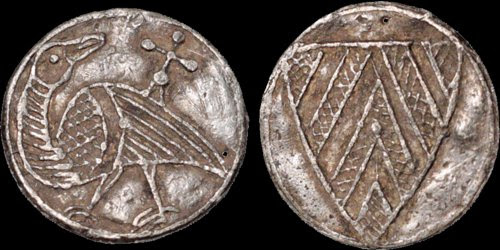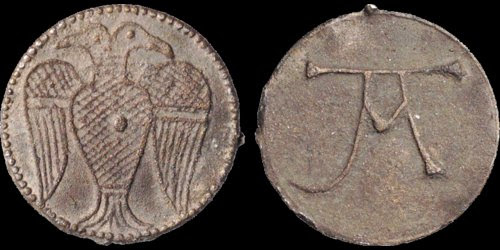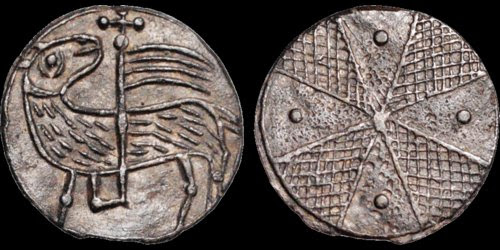
PREV ARTICLE
NEXT ARTICLE
FULL ISSUE
PREV FULL ISSUE
ENGLAND’S FIRST TRADE TOKENSThe Davisson's E-Auction 20 closes Wednesday, June 7th, 2017. In one of their email newsletters promoting the sale they included a nice article about early English Trade Tokens.
With permission, here is a lengthy excerpt. -Editor
When did the use of trade tokens in Britain begin? The answer may be during the reign of Edward I whose introduction of a round farthing in 1279 quickly put an end to the need for a token to use as “small change.” This is a possible interpretation provided in a 1971 article by Michael Dolley and W. A. Seaby, two very prominent 20th century numismatists.
These pieces are of a high quality cast, and there was some muling of obverses and reverses. The plate shown is from Akerman’s article. The author of the article was John Akerman, an important 19th century numismatist whom Manville calls “one of the principal mid-nineteenth century architects in encouraging interest in numismatics,” adding that he was a person who “did not suffer fools gladly.” Akerman noted that a need for change was an ongoing problem. “The history of the English coinage furnishes us with many anecdotes, illustrating the inconvenience and misery arising from the want of a proper supply of the fractions of the commonest current coin…” was his observation in the 1840s, a statement well borne out by the many token series—17th century, 18th century early and late, 19th century early and mid-century—that make up a huge chapter in the history of British numismatics. Akerman did not speculate about the time of origin but he did note that there was an unmet need for a farthing coin in an era when a penny (a day’s wage for a laborer at the time) was too large a denomination “for very general use among the poor.” One-hundred-twenty-six years later Dolley and Seaby note that the idea that the pieces originated in the thirteenth century was supported by a find of a “little clump” of similar pieces in a thirteenth-century “Dublin cess pit” used later in the era for general disposal and containing other artifacts that allowed a close estimate of the date. This was the Dublin (Winetavern Street) hoard. They suggest that a Dublin entrepreneur imported a bulk order of these pieces noting that tin was a valuable metal and this group was nearly two pounds. They think the total number would have been 4320 or 5184 depending on the quantity ordered—long “hundreds” or two gross of each variety. The shipment could well have been abandoned when there was legal pressure against its use. But the fact that it was ordered in the first place suggests that someone was manufacturing a token unit of exchange that was well enough made to a consistent standard that a merchant—a tavern owner is suggested by Akerman—would buy them for small change needs. A 1984 British Numismatic Chronicle by Michael Mitchiner and Anne Skinner disagrees arguing that “Although base metal tokens were frequently used as an alternative to small denomination official coinage, the medieval token should not really be conceived as a straight monetary substitute: at least not until after the Reformation so far as England is concerned.” In their exhaustive and detailed discussion of tokens in this era they do observe that “Circulation of these tokens during the second half of the thirteenth century is clearly attested by extant evidence.” Their article is rich with detail: Who? Probably ecclesiastical (“1307 marks the first recorded citations of English secular pewterers in London.”) They do not pin down an exact use leaving room for the token speculation. How made? Stone molds. Why pewter? More durable than lead. Designs? Decorative rather than informative. The authors also provide extensive lists of varieties and die combinations.    To come back to the question that started all this: Are these the first examples of “trade tokens” in England. Dolley and Seaby concluded that “the 1971 discovery in Dublin has established beyond all possibility of refutation that objects of the class first described by Akerman are (a) authentic, (b) numismatic and (c) of late thirteenth-century date.” The social and economic issues that led to later outbursts of token production—small change for working men—were present. Accounts of the time refer to the use of silver farthings, something that was far more awkward when one had to cut down a penny. Whether the pieces were intended to serve a monetary function or not, the point is that there is a logic to it having been a use. Like the 18th century tokens that have become the dominant enthusiasm of so many collectors these issues offer an elegance of design and, generally, superior condition (Dolley and Seaby noted that “the condition of the individual pieces is superb”). Finally, like all the other token series that were created for a needy public, this fascinating little numismatic chapter provides a tangible tie to an era eight centuries past. To read the complete article, see:
To browse E-Auction 20, see: https://davcoin.com/sale/E-Auction%2020  Wayne Homren, Editor The Numismatic Bibliomania Society is a non-profit organization promoting numismatic literature. See our web site at coinbooks.org. To submit items for publication in The E-Sylum, write to the Editor at this address: whomren@gmail.com To subscribe go to: https://my.binhost.com/lists/listinfo/esylum All Rights Reserved. NBS Home Page Contact the NBS webmaster 
|
